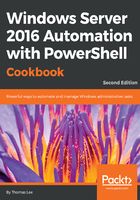
上QQ阅读APP看书,第一时间看更新
How to do it...
- You use the Show-Command to investigate the Get-FileHash cmdlet:
Show-Command -Name Get-FileHash
Show0-Command is not available in the Server Core version, as it lacks the graphical user interface.
- In the dialog that pops up, the Path tab corresponds to one of three parameter sets for this command. For the Path tab, enter $Env:windirnotepad.exe or any other valid file path.
- Choose an algorithm like SHA512 from the drop-down menu.
- Click the Copy button then paste the command into your PowerShell ISE and press Enter to run it. Note the hash value that is returned.
- Use Show-Command to investigate Test-NetConnection:
Show-Command -Name Test-NetConnection
- In the dialog box, the CommonTCPPort tab corresponds to the default parameter set, the first of four. Choose HTTP from the CommonTCPPort drop-down, and choose Detailed for InformationLevel. Then click Copy, and paste the script into your editor below the Show-Command line, then close the Show-Command window. Select this line and press F8 to run this line.
- Repeat your call to Show-Command -Name Test-NetConnection. Choose the ICMP tab and enter a valid internet hostname like Windows.Com in the ComputerName field, or leave it blank, and choose Detailed for InformationLevel.
- Click the Copy button then paste the command into your PowerShell ISE below the previous command, then close the Show-Command window and select the line and press F8 to run it.
- Repeat your call to Show-Command Name Test-NetConnection. Choose the NetRouteDiagnostics tab, check the box for DiagnoseRouting, and click Run.
- Repeat your call to Show-Command -Name Test-NetConnection. Choose the RemotePort tab, enter 443 for the Port, and choose Detailed for InformationLevel, and click Run.